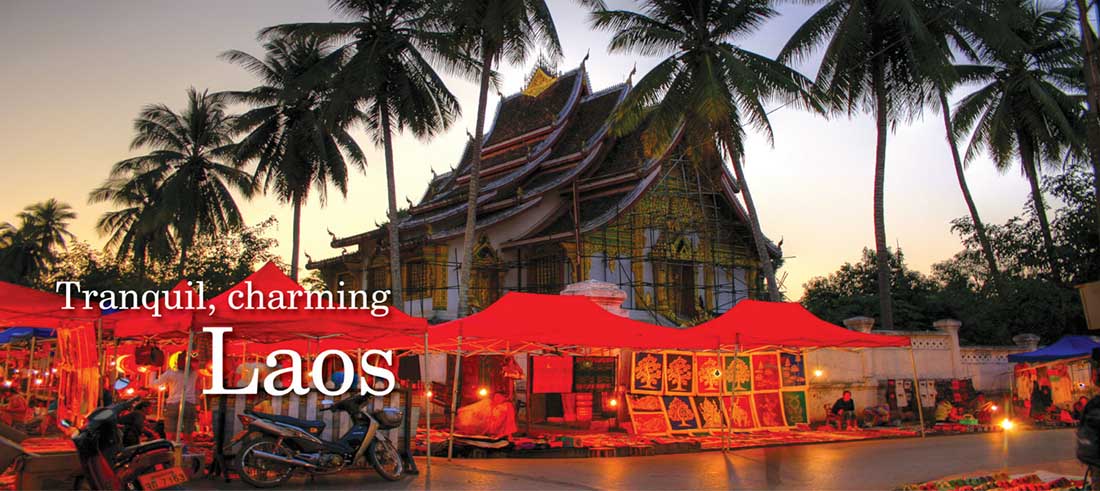Laos overview
Laos is a landlocked country located in the centre of Indochine. It has common borders with China, Myanmar, Thailand, Cambodia and Vietnam. Laos is 236,800 sq. km in land area, the major part being mountainous and forested. Geographically, the country is divided into three areas: the North, the Central and the Southern parts.
Famous for its relaxed atmosphere, the country never fails to deliver guests unique experiences and unexpected moments of discovery with every visit. Most visitors travel to the capital city Vientiane and then head north to historic royal city of Luang Prabang where watching as hundreds of saffron-robed monks move silently among centuries-old monasteries is as romantic a scene as you’ll experience anywhere in Asia. With plenty of sightseeing, activities, and traveler facilities it is no wonder that these two cities continue to draw the most visitors. Away these two cities, there is so much more to see: the cool highlands of the Bolavan Plateau in the southern part of the country, the Plain of Jars in the north-east makes for a mysterious diversion into one of Laos’ least-visited regions, the forested mountains of Northern Laos, the gothic limestone karsts around the backpacker-haven Vang Vieng and in the deep south, past the market town Pakse, is the sleepy 4000 islands of Si Phan Don, where the mighty Mekong spreads out and all the hammocks are taken. There are also plenty of opportunities to get off the beaten track, with some of South-East Asia's best trekking opportunities to be discovered in Laos north-eastern Phongsali region.
Despite having two distinct weather seasons you can travel in Laos all-year-round and with no coastline to influence things. From November to February the weather in Laos is cool and dry while March to June sees temperatures soar-ing in to the high 30s (Celsius). The early months of the wet season (May-July) remain very hot and rainfall is often short lived, whilst in the latter months (July to October) the rains can be heavy, thus making rural areas inaccessible. Across Laos, throughout much of the rainy season, daytime temperatures average around 29°C in the lowlands and 23°C in the mountain valleys.
Pii Mai, Lao New Year, is in April and the celebrations include parades and water fights. The magnificent That Luang Festival falls in November and thousands of people and monks travel from remote villages to participate in the religious celebration. Several times a year Vientiane has boat racing competitions, where long wooden boats are raced up and down the Mekong.
Key Festivals
Citizens of the UK, EU countries, Australia, New Zealand, Canada and the United States and almost all other nations will require a visa to visit Laos. The standard tourist visa is a single entry visa that allows you to travel in Laos for 30 days from the date of your entry. If you exist Laos for an extension trip to Vietnam, Cambodia, or Myanmar, you will require a new visa to enter.
Please note that the citizens of the following countries may not get their Visa on Arrival in Laos: Afghanistan, Algeria, Bangladesh, Burundi, Cameroon, Congo, Cote d’Ivoire, Ghana, Guinea, Guinea Bissau, Jordan, Lesotho, Liberia, Libya, Mozambique, Nauru, Niger, Nigeria, Pakistan, Senegal, Sierra Leone, Sri Lanka , Suriname, Syria, Swaziland, Tonga, Turkey, Zambia and Zimbabwe. Citizens of above countries must obtain their visa at Lao Embassy or Lao Consular before entering to Lao PDR (except on official visit).
Visa on Arrival Procedure
You can obtain the visa on arrival at all international airports or at your land border crossing. Visa fee is from $30 to $45 depending on the traveler nationality and two up-to-date passport photo.
Contact Information
Head Office: No. 2D, Tuc Mac Lane, Hoan Kiem Dist, Hanoi, Vietnam
Tel: +84 (24) 3942 9922
Fax: +84 (24) 3941 6616
Email: contact@sentravel.asia
© 2014 Sen Travel, all rights reserved

